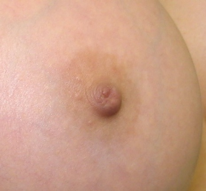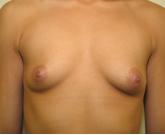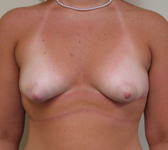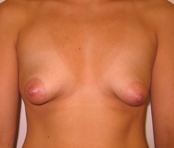The breast exam is obviously the focus of the pre-operative evaluation. The breast (plate) thickness and the “pinch test” and its importance were described in the previous section. This is done to help determine the specific procedures recommended to the patient (along with many other factors). Breast ptosis (sagging) is also evaluated at the pre-operative appointment. Virtually all women that have reached maturity have some degree of breast ptosis (sagging) in the sitting or standing position. The exception is women with very small breasts because there is not enough extra skin to allow sagging. It is very common to observe differing amounts of breast ptosis (sagging) in the same patient (one breast sags more than the other breast). This creates breast asymmetry. Patients have varying degrees of ptosis (sagging) that can be divided into groups using a classification system. One classification system to describe breast ptosis that is commonly used is called the Regnault Breast Ptosis Classification (see chart below). The degree of breast ptosis (sagging) is defined by the relationship of the nipple-areolar complex and the breast mound itself to the infra-mammary fold (the crease below the bottom of the breast).
Regnault Breast Ptosis Classification


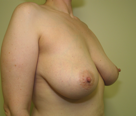


The degree of ptosis (sagging) is a major determinant of which procedure or procedures are recommended to the patient. Patients that have small degrees of ptosis (and no other anatomic variations) do not need any additional procedure (breast lift, mastopexy) other then the basic breast augmentation procedure. A small degree of ptosis (sagging) is very natural and gives the breast its normal fullness in the lower outer quadrant (part of the breast next to the elbow in the standing of sitting position). Patients with severe ptosis (sagging) usually need a lifting procedure (mastopexy) in addition to the breast augmentation procedure. Patients with an intermediate degree of ptosis (sagging) can choose a breast augmentation alone (and accept some extra sagging with only one procedure) or a breast lifting procedure (mastopexy) combined with a breast augmentation procedure, and in some cases a breast lift (mastopexy) alone.
In the group of patients with moderate ptosis (sagging) an increase in breast volume may be the only goal of the patient. Other patients may desire the “ideal result” which would include a breast lifting procedure (mastopexy) and a breast augmentation procedure. The advantages of the combined procedure is a fuller breast and youthful more uplifted breast. The disadvantages of the combined breast lift (mastopexy) and breast augmentation procedure is a significant addition of more scars, and extra cost. The breast lift-breast augmentation can be done at the same time or can be “staged”, which means the procedures are performed at different times with a healing period in between the two. There is also extra risk of wound healing problems with the combined breast lift (mastopexy) and breast augmentation procedure, especially if these procedures are done at the same time. There is also a higher rate of surgical revisions in the group of patients getting the combined procedure. The choice of the single procedure or the combined procedure is left entirely to the patient after a thorough informed consent. It is very important for the patient with moderate ptosis choosing the single procedure (breast augmentation alone) that they fully understand and accept the limitations of the single procedure, which is some degree of ptosis (sagging). The breast lift (mastopexy) procedure is discussed in another section.

Earlobe asymmetry
Asymmetry in the human body is the exception rather than the rule. Minimal asymmetry in the human body is rarely ever noticed except under close inspection. Even significant asymmetry is not noticed in many circumstances. As an example, I have queried many patients about the one the most popular entertainers in the history of the entertainment business. With one exception, no one had ever noticed that Frank Sinatra’s ears are noticeably asymmetrical. His left ear had a small lobe and his right ear had a much larger lobe by comparison. Both earlobes are normal, but are quite different. Once pointed out, this asymmetry is very obvious, but it is rarely even noticed by the causal observer, or even by the ardent fan. The point is, minor asymmetry is rarely noticed except on close examination and should be of no great concern to the patients. Significant asymmetry is a legitimate concern that is very reasonable to address with the breast surgeon. Significant asymmetry is addressed and corrected if possible, and improvement is possible in most patients.
Breast asymmetry is not considered a developmental deformity but is considered a normal anatomic variation. Asymmetry is observed in the entire body and anatomic variation is described in anatomy textbooks as “normal variation”. Again it is very unusual for a patient to have exact symmetry of the breasts. Most patients will have some degree of breast asymmetry if examined closely. Breast symmetry ( or asymmetry) is evaluated at the initial consultation. There are many presentations (types) of breast asymmetry.
The most obvious is breast asymmetry related to breast size. This is the most common concern related to breast asymmetry expressed by patients seeking breast augmentation. Some patients will have a minimal amount of asymmetry and will not be aware of it. Other patients will have a significant amount of asymmetry. For example, a “D cup” on one side and a “” B cup” on the other side. These patients require specific considerations and different approaches as compared to the patient with mostly symmetrical breast augmentation patients. Patients seeking breast augmentation with large degrees of breast asymmetry are not the most frequent category observed. Fortunately, the patients with a large degree of symmetry (“D cup on on side and “B cup ” on the other”) can get great improvements by undergoing specific breast procedures. It is impossible to completely and perfectly correct breast asymmetry, but breast asymmetry can usually be corrected to within normal anatomic variation.
- Breast asymmetry 1
- Breast asymmetry 2
Another type of breast asymmetry is related to breast shape. This type of asymmetry is very common, and arguably ubiquitous. For example, a patient may have a rounded breast on one side and have a conical shaped breast on the other side. The breasts have the same volume but are different shapes. Another type of shape asymmetry is one breast being more full in the lower hemisphere than the opposite breast. Breast augmentation alone can help minimize these shape differences in most patients. In some patients, additional procedures are required for the optimal result.
Another type of breast asymmetry is related to the size, shape, and position of the nipple areolar complex. Patients frequently voice concern about the size, shape, and position of the nipple-areola complex (too large, too small, too light, too dark). If there is asymmetry in the shape and size of the breast gland, then it flows that there will be asymmetry in the nipple areolar-complex in some patients. The nipple areolar-complex may be higher, lower, more lateral (to the outside of the chest) or more medial (to the inside of the chest). In some patients the position of the nipple areolar-complex can be adjusted with the breast augmentation procedure. The areolar-complex can also be asymmetrical, that is, one side is shaped differently than the other. Additional procedures may be needed to correct this asymmetry in some patients. The size of the nipple areolar-complex on average is 35 to 45 millimeters (3.5 to 4.5 centimeters). In some patients, the nipple –areolar complex is much larger, sometimes reaching over 8 centimeters. In some patients the nipple-areolar complex is smaller than normal (less than 35 millimeters in diameter). Asymmetry in nipple-areolar complex size is very common. Variations in nipple-areolar complex size can sometimes be corrected at the time of breast augmentation. The “normal” nipple areolar complex in the adult human breast is usually not exactly round (when the patient is in the sitting or standing position). This is especially true as the aging process affects the breast and the areolar-complex. As aging progresses, the areolar becomes more ovoid with the long axis going from head to toe. The breast augmentation procedure alone usually does not correct asymmetry or other anatomical variations about the nipple–areolar complex.
The nipples are also frequently asymmetrical in the human breast. One variation that is observed in the human female breast is the “inverted nipple”. The inverted nipple is caused by relatively short lactiferous ducts. If the lactiferous ducts between the breast gland and the nipple-areolar complex are too short, then the nipple will be retracted to inverted lactiferous (milk) ducts are the pathway (tubes) from the milk producing glands to the nipple. This can cause concern in healthy patients and can also cause difficulty in breast feeding. In healthy patients that have inverted nipples their entire adult lives, it is usually not a pathological sign. Inverted nipples in this circumstance should always be considered a possible pathologic sign of breast cancer and should be evaluated by a primary care physician. This is especially true when this condition occurs later in life, or occurs suddenly. Inverted nipples (non-pathological, normal variant) can sometimes be corrected with a breast augmentation alone. In other patients, the correction of inverted nipples requires a separate surgical procedure. Inverted nipples can (much less frequently) be a pathologic sign in young patients. This is especially true if the inverted nipple is unilateral (only on one side) or is a new condition (occurred sometime after breast development was completed). Inverted nipples are very common (and considered a normal variant) in newborns.
- Inverted nipple
- Corrected inverted nipple
Note: Breast surveillance (exam, imaging, and sometimes genetic testing) should always be performed by your primary care physicians (Ob-Gyn, family practice, internal medicine) at the prescribed intervals according to the prevailing standard of care.
The color of the nipple-areolar complex varies widely from patient to patient, but variation in color (right different from left) is not common. Occasionally a patient is encountered that has vitiligo (portions of the skin lose their pigment) of the areolar-complex but this is uncommon.

vitiligo of the breasts
Chest wall asymmetry is also commonly observed in patients seeking breast augmentation. The position and symmetry of the chest wall is an important factor to define prior to the breast augmentation procedure. The chest wall is the platform upon which the breast rests. Therefore, the shape and position of the chest wall will directly affect the final appearance of the breasts. In addition, two other conditions are frequently seen that will affect the final appearance of the breasts after breast augmentation. One is named pectus carinatum, which is usually considered an anatomic variation except in extreme circumstances. In this circumstance, the chest comes to an angle in the middle (between the breasts). In this situation, the breasts will be angled more to the outside (away from the middle) which would give less cleavage. Another anatomic variation is named pectus excavatum which is a depression in the middle of the chest (between the breasts). In this anatomic variation, the breast will point more towards the middle of the chest giving more cleavage. Pectus carinatum and pectus excavatum are observed in varying degrees of severity. Most patients that have either of these conditions will not have this surgically corrected. When the condition is minor, some cosmetic correction can usually be achieved by the placement of the implants. In more severe cases, correction cannot be achieved by breast augmentation alone. These conditions are sometimes corrected when there is a physiologic problem (poor circulation, poor respiration) that affect daily living activities.
In addition to pectus carinatum and pectus excavatum, chest wall asymmetry can also adversely affect the breast augmentation procedure. In the circumstance of chest wall asymmetry, one side of the chest is higher (has more projection) than the other side. As a result, if the same size implants are placed on both sides, then one breast will have more projection (stick out further ) than the other side. If different size implants are placed in order to achieve matching projection, then the breasts will obviously be different sizes. In this situation as always, the choice is left to the patient and most choose to compromise between either ideal to achieve some symmetry in breast size and breast projection.
- Pectus carinatum patient 1
- Pectus carinatum patient 1
- Pectus excavatum patient 2
- Pectus excavatum patient 2
The infra-mammary fold is the term for the crease at the bottom of the breast. It is an anatomic entity that separates the bottom of the breast proper from the upper abdomen. The infra-mammary fold is more easily observed in patients with larger breasts and some degree of ptosis (sagging). Asymmetry in the infra-mammary fold is commonly observed in patients seeking breast augmentation. If the asymmetry of the infra-mammary fold is minor, then no adjustment is needed. If asymmetry of the infra-mammary fold is significant, then it can be adjusted in conjunction with the breast augmentation procedure.
The “constricted” breast is an anatomic variation in which the base of the breast is too narrow. In other words, the combined diameter of the breasts is too small to match the diameter of the chest, which results in disproportion. The goal in this group of patients is to expand the diameter of the base of the breast so that the breast diameter is in normal proportion with the diameter of the chest. There are a number of surgical procedures to achieve this goal at the same time as the breast augmentation procedure.
- Constricted breast patient 1
- Constricted breast patient 2
The breast can be positioned on the chest wall at different heights. In other words the breast can be asymmetrical (uneven) based on the position where the base of the breast is positioned on the chest wall. The breasts are the same volume and shape, but are at different heights on the chest wall. If asymmetry due to breast position is minor, then it is inconsequential and does not require correction. If the asymmetry of the breasts due to breast position on the chest wall is severe, then it can usually be improved at the same time as the breast augmentation procedure.
The tuberous breast (herniated breast) is a condition where the breast glandular tissue grows forward (and herniates) into the nipple-areolar complex. If the herniation is minor then it does not require repair, but if the herniation is severe then it can be repaired at the time of the breast augmentation procedure. The goal in this circumstance is to reduce the herniation of the breast to its normal position and normal appearance. This breast condition is sometimes referred to as the “Snoopy deformity”. The tuberous breast can be similar to the constricted breast, but in addition to constriction of the base of the breast, the breast gland proper is herniated into the nipple areolar complex.
- Tuberous breast patient 1
- Tuberous breast patient 2




